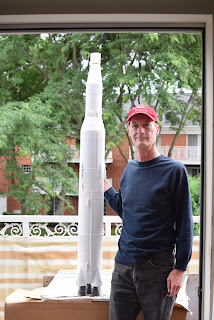Example: This is the Industry standard color coat over the Mr. Surfacer 1200, which sprayed a nice gray undercoat. (Industry Standard meaning the most popular line of hobby colors.)
This is the coverage that resulted.
Although the picture dosen't show it as well, there was considerable issues with the color looking more like a wash, than a true paint job. it also had quite a bit of shine, even though it was a Matte/Flat color.
I only masked off the rocket pods, and it took 4 mist coats to even get this poor level of coverage, while the surfacer covered in just two mist coats.
That is a big concern, since, as you can see, there was very little coverage, considering that I used a whole 100ml can of a not inexpensive color coat for just that small area. I could sand and finish the fine grained white and black surfacers, they would look and feel the smoothness from 2500-4000 grit sanding sponges, while retaining that flat look. The smoothness of the surfacer would also provide a great finish for laying decals without the need for a gloss coat to give better adhesion. When you know the proper way to finish a Lacquer, whether it be a primer, primer-surfacer, or color coat, those extra ounces of color coat were, to me, a waste of both time and money. That's why I just used the Mr. Hobby Primers and Primer-Surfacers, which, in the end, gave a more realistic, almost utilitarian finish, which, to me, best reflected the reason for a finish on the rocket in the first place, the white, to cover the aluminum skin to prevent corrosion, and the black areas, which were there to give reference marks so that any rolling of the rocket could be confirmed.
The primer and primer-surfacer gave me the best finish to work, and spared me the expense and time that I would have had to do after the color coats were laid down. Why repeat the work twice, when those coats worked and looked like an actual color coat finish.
You be the judge...
That, to me, most reflected the finish as both utilitarian and aesthetic.
What do you think?













